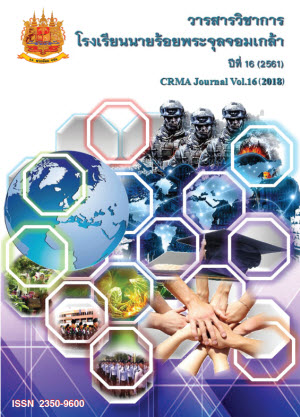การศึกษาระยะเวลาสัมผัสที่เหมาะสมในการเดินระบบเมมเบรนและโฟโตคะตะไลติกเมมเบรนเพื่อบำบัดน้ำเสียโรงพยาบาล
Main Article Content
บทคัดย่อ
บทความนี้เป็นการศึกษาระยะเวลาสัมผัสที่เหมาะสมของระบบเมมแบรนและระบบโฟโตคะตะไลติกเมมเบรนมาใช้ในการบำบัดน้ำเสียจากโรงพยาบาลสงขลานครินทร์ โดยทำการผลิตเมมเบรนเซรามิกส์และเมมเบรนโฟโตคะตะไลติกที่ใช้เมมเบรนเคลือบด้วยไทเทเนียมไดออกไซด์และทำงานร่วมกับแสงยูวีในการฆ่าเชื้อโรค ซึ่งระบบเมมเบรนกรองเป็นแบบ outside–in โดยใช้อัตราการไหลที่ศึกษาแตกต่างกัน คือ 38 60 และ 120 มิลลิลิตรต่อนาที ตามลำดับ และระยะเวลาสัมผัสเป็น 1.25 2.6 และ 5.3 นาที ตามลำดับ พบว่า ระยะเวลาสัมผัสที่เหมาะสมต่อการบำบัด คือ 1.25 นาที ที่อัตราการไหล 120 มิลลิลิตรต่อนาที โดยมีค่าฟลักซ์เป็น 198 ลิตรต่อตารางเมตรต่อชั่วโมง สำหรับประสิทธิภาพในการบำบัดซีโอดีของระบบบ่อเติมอากาศ ระบบเมมเบรนและระบบโฟโตคะตะไลติกเมมเบรน คิดเป็นร้อยละ 78.13 79.69 และ 94.14 ตามลำดับ และไม่พบโคลิฟอร์มทั้งหมดและฟีคัลโคลิฟอร์มทั้งหมดในระบบโฟโตคะตะไลติกเมมเบรนเนื่องจากกลไกการแตกตัวของไฮดรอกซิลเรดิคอลทำปฏิกิริยากับสารอินทรีย์และจุลินทรีย์โดยตรงโดยมีแสงยูวีเป็นตัวร่วมในปฏิกิริยาจึงทำให้มีค่าซีโอดีต่ำสุดและไม่พบเชื้อโรค
Article Details
ผลงานที่ได้รับการตีพิมพ์ ถือเป็นลิขสิทธิ์ของวารสารฯ
เอกสารอ้างอิง
สมชาย สกุลอิสริยาภรณ์, 2540. การพัฒนารูปแบบการกำจัดน้ำเสียในโรงพยาบาลของกระทรวงสาธารณสุข. วารสารการส่งเสริมสุขภาพและอนามัยสิ่งแวดล้อม, ปีที่ 20, ฉบับที่ 3 หน้า 65-74.
Ferlay, J, Soerjomataram, I., Ervik, M, Dikshit, R., Eser, S., and Mathers, C., 2013. Cancer Incidence and Mortality Worldwide: IARC Cancer Base No. 11.
Álvarez-Torrellas S., Peres, J.A., Gil-Álvarez, V., Ovejero, G., and, J. García., 2017. Effective adsorption of non-biodegradable pharmaceuticals from hospital wastewater with different carbon materials. Chemical Engineering Journal, 320: 319-329.
Petri, A., Sergei, P., Timo, V., Mänttäri M., Kallioinen, M., and Marjatta, L.- K.., 2018. Hospital wastewater treatment with pilot-scale pulsed corona discharge for removal of pharmaceutical residues. Journal of Environmental Chemical Engineering, 6: 1569 -1577.
Arslan, A., Veli, S., and Bingöl, D., 2014. Use of response surface methodology for pretreatment of hospital wastewater by O3/UV and O3/UV/H2O2 processes. Separation and Purification Technology, 132: 561 - 567.
กรมควบคุมมลพิษ, 2550. คู่มือการจัดการน้ำเสียอาคารประเภท ก ประเภทโรงพยาบาล ศูนย์ช่วยเหลือให้ปฏิบัติตามกฎหมายสิ่งแวดล้อม [Online] http: www. http://ptech.pcd.go.th
Tchobanoglous, G., Burton, F. L. and Stensel H. David., 2004. Wastewater engineering treatment and reuse 4th edition. Metcalf & Eddy, Inc. The McGraw-Hill Companies.
สุบัณฑิต นิ่มรัตน์, 2548. จุลชีววิทยาของน้ำเสีย. กรุงเทพฯ: สำนักพิมพ์จุฬาลงกรณ์มหาวิทยาลัย.
สำนักงานนโยบายและแผนสิ่งแวดล้อม, 2538. โครงการศึกษาเพื่อจัดลำดับความสำคัญการจัดการน้ำเสียชุมชน, เล่มที่ 2 ฉบับสมบูรณ์. กระทรวงวิทยาศาสตร์เทคโนโลยีสิ่งแวดล้อม.กรุงเทพฯ:บริษัท ซีเทคอินเตอร์เนชั่นแนลจํากัด.หน้า 3-31 – 3-57.
Fabian, I, Kevin, S., J., Juri, L., Linda, G., Ulf, N., Thomas, A., T., Torsten, Schmidt, C., and Jochen, T., 2018. Comprehensive analysis of antagonistic endocrine activity during ozone treatment of hospital wastewater. Science of the Total Environment, 624: 1443–1454.
Ferre,-A., J., Valcárcel, Y., Negreira, N., López de Alda, M., Barceló, D., Cardona, S., C., and Navarro,-L., J., 2016. Ozonation of hospital raw wastewaters for cytostatic compounds removal. Kinetic modelling and economic assessment of the process. Science of the Total Environment, 556: 70–79.
New York State Energy Research and Development Authority, 2004. Evaluation of Ultraviolet (UV) radiation disinfection technologies for wastewater treatment plant effluent.
Manouchehri, M. and Kargari, A., 2017. Water recovery from laundry wastewater by the cross flow microfiltration process: A strategy for water recycling in residential buildings. Journal of Cleaner Production, 168: 227-238.
Zhang, W., Ding, L., Luo, J., Jaffrin, M. Y., and Tang, B., 2016. Membrane fouling in photocatalytic membrane reactors (PMRs) for water and wastewater treatment: A critical review. Chemical Engineering Journal, 302: 446-458.
Chakraborty, S., Loutatidou, S., Palmisano, Gi., Kujawa, J., Mavukkandy, M. O., Al-Gharabli, S., Curcio, E., and Arafat, H.A., 2017. Photocatalytic hollow fiber membranes for the degradation of pharmaceutical compounds in wastewater. Journal of Environmental Chemical Engineering, 5: 5014-5024.
American Public Health Association, American Water Works Association, Water Environment Federation, 2012. Standard Methods for the Examination of Water and Wastewater, 22rd Edition.
ประกาศกระทรวงทรัพยากรธรรมชาติและสิ่งแวดล้อม เรื่อง กําหนดมาตรฐานควบคุมการระบายน้ำทิ้งจากอาคารบางประเภทและบางขนาด ลงวันที่ 7 พฤศจิกายน พ.ศ. 2548.
Bhongsuwan, D., and Bhongsuwan, T., 2007. Slip casting of alumina for membrane application. Journal of Applied Membrane Science & Technology, 6: 37-45.
Guo, B., Pasco, V., E., Xagoraraki, I., and Tarabara, V., V., 2015. Virus removal and inactivation in a hybrid microfiltration–UV process with a photocatalytic membrane. Separation and Purification Technology, 149; (27), 245–254.
โรสนา กาซอ, 2552. การศึกษาการจัดการน้ำเสียชุมชนในมหาวิทยาลัยสงขลานครินทร์ วิทยาเขตหาดใหญ่. วิทยานิพนธ์ระดับปริญญาโท, มหาวิทยาลัยสงขลานครินทร์.
Hamid, R., M., Mehran, A., and Toraj, M., 2018. Synthesis, characterization and performance evaluation of an optimized ceramic membrane with physical separation and photocatalytic degradation capabilities. Ceramics International, 44; 10281–10292.
Goswami, D.,Y., Trivedi, D.,M., and Block, S.,S., 1997. Photocatalytic disinfection of indoor air. Journal of Solar Energy Engineering-Transactions of the ASME, 119; 92–96.
Gaya, U.,I., and Abdullah, A.,H., 2008. Heterogeneous photocatalytic degradation of organic contaminants over titanium dioxide: A review of fundamentals, progress and problems. Journal of Photochemistry and Photobiology C: Photochemistry Reviews, 1; 1–12.
Kaishu Guan., 2003. Relationship between photocatalytic activity, hydrophilicity and self-cleaning effect of TiO2/SiO2 films, Surface and Coatings Technology, 191: 155-160.


